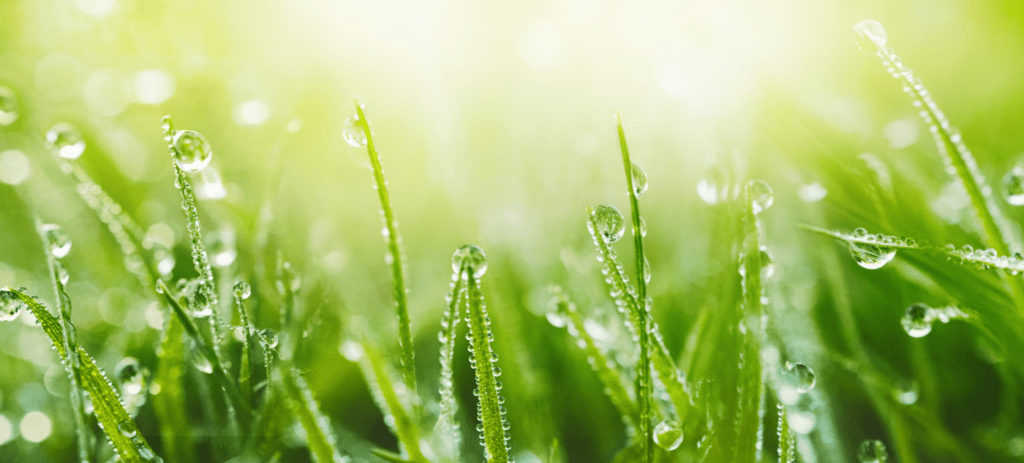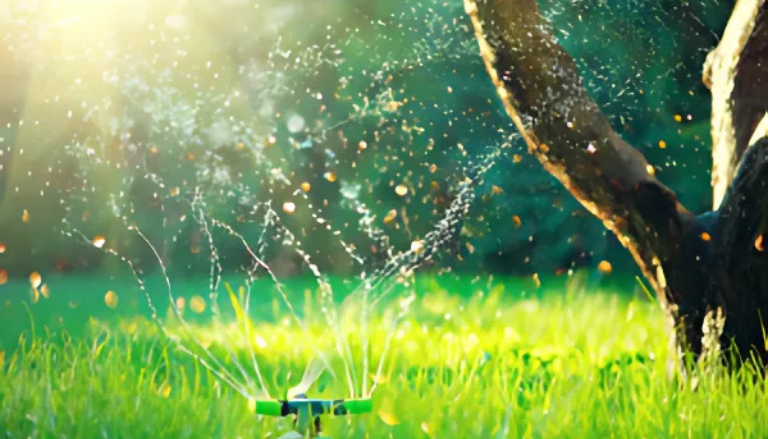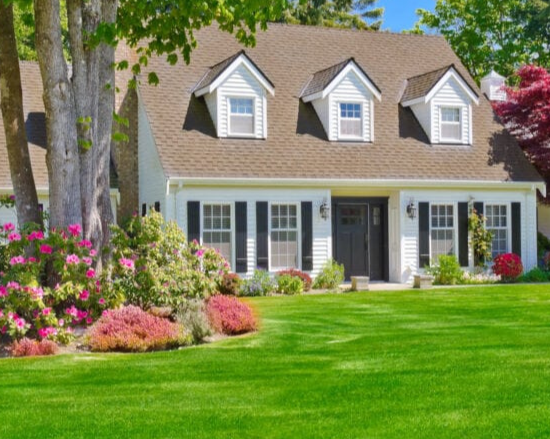We’ll explain everything you need to know about watering an established lawn: the importance of watering your lawn, the three methods of watering (at the end of this text), automating your watering, and much more.

The importance of watering
In order to achieve a healthy and stunning lawn, it is extremely important to irrigate it. Water is the most important element if you want to achieve beautiful results. In fact, I would say that my first piece of advice if you want a beautiful lawn is to not neglect its watering. As they say: water is life. Moreover, grass is composed of more than 70% water!
When to water? (Important to know)
- When the lawn shows it needs watering.
- When conditions are dry and it has not rained for a long time (preventive watering).
- If you see yellowing, whether it is a lack of water, damage of any kind, or pest problems (to increase recovery or limit damage).
- If your lawn is in poor condition (i.e. new customers, previous damage, etc.) we recommend increasing the watering frequency until the lawn looks good again.
It is not necessary to water if there is rain or if we have a dew in the morning.

Fertilizer and water
You must also understand that the fertilizers* applied by Génie en Herbe require water in order to penetrate to the roots of the grass and allow the nutrients to be absorbed. Therefore, in order for the nutrients to work and improve your lawn, it is important to have adequate irrigation. In other words, if you don’t water or if it doesn’t rain, the results of fertilization will not be remarkable. In addition, a fertilized lawn may, in some cases, require more water because the fertilizers applied are, in fact, mineral salts and these can create an osmosis reaction increasing the water requirements (it’s the same principle as when we eat salty food and it makes us thirsty).
*fertilizer synonyms: vitamins, nutrients and mineral salts

Influence of weather factors
In some seasons, it can be much more difficult to get great results! In fact, rain is our most important ally when it comes to lawn irrigation. I would like to point out that there is nothing better than rain to water our lawn. However, in some cases, such as in 2020, heat waves and lack of water have brought extremely harsh, dry conditions and this has had a direct impact on the health and appearance of lawns. In addition, a lawn that lacks water eventually falls into a stressful situation. In other words, it is much more vulnerable and it is advisable to avoid this condition.

The potential impact of water stress (lack of water) on a lawn
Water stress weakens the lawn, making it much more vulnerable. For example, parasitic insects such as chinch bugs, white grubs and sod webworms will wreak havoc much more quickly. Also, as trivial as it may be, an area where your lawn is often walked on during a water shortage situation could suffer irreversible damage and die. Mowing during a water shortage could also cause damage. All this to show you that a stressed lawn is certainly not a good thing.
A stressed lawn will never look great even if it receives treatment.

The ability to go dormant
Of course, as a result of a significant lack of water, the lawn has the ability to go “dormant”. Dormancy is the condition/ability of grass to survive periods of drought. Dormant turf is yellow, but it is not dead. It is a temporary yellowing until conditions become suitable again (lots of rain). However, in order to achieve beautiful and long-lasting results, I do not recommend relying on this ability of the grass to withstand hot and dry weather. However, don’t worry if your grass is dormant. It is simply not recommended to let it go dormant, if you want to avoid potential problems and if you want to have a beautiful lawn! On the other hand, it is much more difficult for us to diagnose other problems such as chinch bug outbreaks.
If you have laid sod or seeded, I highly recommend that you water more often. Even after two years, significant damage could be caused by a heatwave.

Favoring preventive watering
Preventive watering is best because it doesn’t require a lot of water and prevents the grass from being stressed. Once the grass has become stressed, much more water is needed! Also, it is virtually impossible to regrow a lawn when it has gone dormant (only rain can really do that). It is much easier to prevent it from going dormant with preventive watering.
Other methods of prevention
Getting a good root system is one of the best ways of prevention. Certain treatments such as mycorrhizae and aeration improve the root system of the lawn, making it much less susceptible to water shortage. An increased root system is able to draw water from the soil more deeply. The lawn then requires less watering. Also, when watered, the benefits of watering increase. If you would like any of these treatments, please let us know in this email.
Even if the treatments are effective, they won’t prevent the need for watering during dry spells.

Automation of your watering
Over the years, I have noticed that lawn watering is often neglected. The main reason is the lack of time available to Quebecers. My recommendation is to automate your watering with the purchase of a timer. The timer allows for precise watering at the best time of the day.
This will make your life easier and will allow you to save water because it is very easy to forget about the sprinkler, thus wasting water (this will avoid any excessive use of water). It is not necessary to have a sprinkler system in order to have an efficient and automated watering system.
You will find this type of product in big box stores (Reno Depot, Home Depot, etc.), nurseries (Botanix, Locas, etc.), and on the Internet (Amazon, Ebay, etc.).
You should know that the watering of a lawn is done with a device that we put at the end of the hose (as shown above) in order to obtain a good coverage. I strongly advise you not to use a hand gun or the hose because the amount of water and efficiency will be less.
Never put a timer permanently on the interior hose of your house. If it is faulty, it could cause water damage.

What is the best time of day to water?
The best time to water is early in the morning. If you are using automatic timers, you will be able to program the watering early in the morning. Otherwise, if you don’t have an automatic timer, I strongly advise you to do it in the evening. Watering in the morning or in the evening has the advantage of providing a prolonged watering because the water has time to penetrate the roots of the grass and to be absorbed (thus countering the evaporation of water on a hot summer day). Finally, if your lawn is extremely stressed by lack of water, it is advisable to water during the day! But if this can be avoided, we do not recommend watering during the day and prioritize preventive watering in the morning or evening.
* The reason why it is preferable to water in the morning is that the soil will benefit from prolonged- but not excessive- watering. Frequent watering in the evening (water remains for a longer period of time before evaporating) can, in some cases, be conducive to the emergence of fungi and fungal diseases.

The three methods of watering
P.S. It is important to follow your city’s regulations when it comes to watering your lawn. If regulations restrict you, please choose a method that will fit.
Before we talk about the three different watering methods, it is important to understand that it is difficult to give a precise guide on watering because the need for watering will vary, depending on the sun exposure of the land, the type of soil, the soil compaction, the flow rate of your hose, the frequency of rainfall, etc. The real answer to the watering question is to do it when your lawn needs it. Only experience and judgment will really get the job done right. As I am often asked for advice in terms of watering, I have prepared the three methods that I think are the most appropriate. Each method has advantages and disadvantages; it will be up to you to choose the one that suits you best.
There are several methods of watering: the precise method, the easy method and the economical method.
Note: the more regularly your lawn is watered, the more you will avoid water shortages and the better your lawn will look. However, there are several ways to do this, depending on what works best for you.
The easy way
_ Ideally, use a programmed timer.
_ Water every other day in the morning or evening (depending on regulations).
_ Water for 20 to 30 minutes, depending on the area and the temperature of the day.
_ The warmer the weather, the longer you should water.
_ Adapt the watering according to the maximum temperature of the day. For example, if it is 35 degrees Celsius today, I recommend watering for about 30-35 minutes. If it is 20 degrees Celsius today, a 20 minute watering will be sufficient. If your lawn is in a state of stress because you have delayed watering it, it may need to be watered for longer.
Advantages:
- Provides constant, consistent watering that won’t allow your lawn to run out of water.
- Provides high performance results in terms of watering and fertilizer absorption (the more frequently the lawn is watered, the more effective the fertilizers are).
- Saves a lot of time.
The economic method
Advantages:
- Very efficient although it is more economical in water.
- Promotes deep rooting (this type of watering allows the grass to become more tolerant to water shortages, creating deeper and more efficient roots).
- Even without an automated system, this type of watering is relatively easy and requires little effort (once a week).
- Water saving.
The precise method
Note: it is the height in water that is important, however, if you are using a measuring cup the ml value is not important. You must measure where on your cup (ml) you get one inch.Advantages:
- You can finally become a watering pro based on measurements (real guide).
- The results will be better because with time you will know exactly how to adjust your watering.
- You will give the necessary water without over-watering and causing fungal disease problems.
- You will provide the necessary water to maximize watering and avoid water shortages.
- Requires more time and passion but is certainly worth it, in terms of results.

The whole team thanks you for your confidence and we wish you a great summer!



